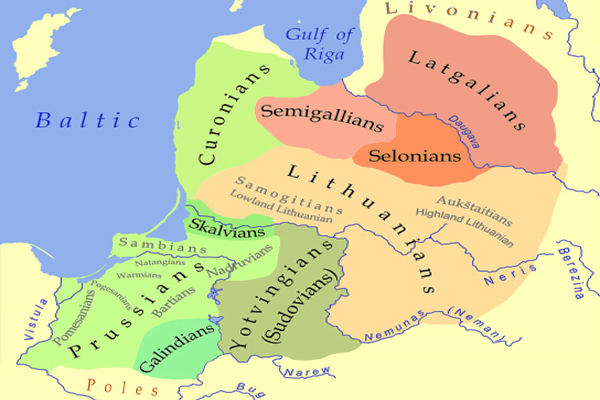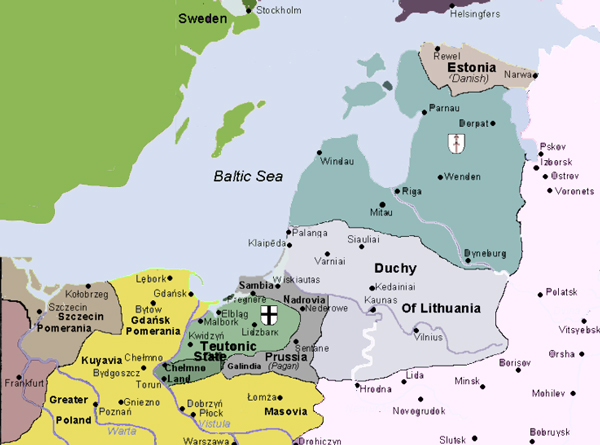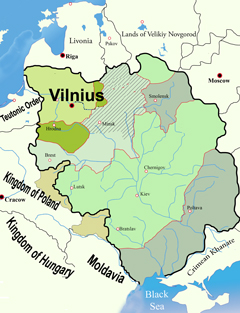The Pensive Christ – "Rupintojelis"
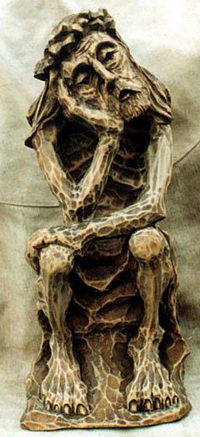
After several centuries of resistance the Lithuanians, the last pagans in Europe, finally succumbed to enforced Christianization.
But a dumb resistance lingers on, even now, in a figure unique to Lithuanian art. A seated, sad and withdrawn Christ – the Rūpintojėlis – is consumed by inner sorrow and the mute distrust of an oppressed pagan people.
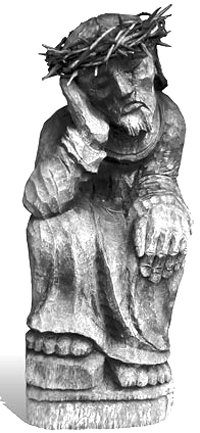
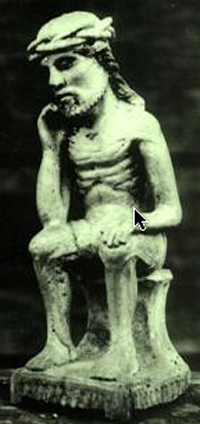
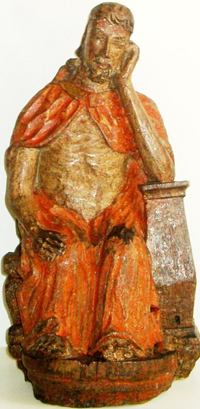
|
The Christianization of the Balts History is written by the victors. They have an exclusivity to the “truth", determining who was right and who was wrong, and specifying who had what virtues and sins. The Christianization of the Balts – the tribes of Lithuania, Latvia, Estonia, and the now extinguished Prussians, is none other. We hear that Christianity brought culture to these savage tribes, and with the help of their Christian faith the Balts joined European civilization. Let us see what Christianity really meant for the fate of the Baltic nations.
The Demise of A Once Strong Nation The Baltic tribes were among the oldest inhabitants in Europe. In antiquity they occupied a much larger area than their contemporary descendants. The Baltic lands stretched much further to the west, to the eastern shores of the Wysla river (now in Poland), as well as further eastwards, about 100 kms beyond the present Lithuanian and Latvian border with Belarus.
The conquest of the Baltic tribes began after the Crusades in the Holy Land suffered disastrous setbacks. After the crusaders lost Jerusalem to Saladin in 1187, their eyes were set on the last pagan areas in Europe. The first crusaders appeared on the eastern shores of the Baltic sea in 1202 and settled in the Daugava delta. They established the castle and the city of Riga, now capital of Latvia. This branch of crusaders was originally called the Brothers of the Sword, later renamed the Livonian Order. Several hundred kilometers southward, in what is now the Kaliningrad district, another branch of crusaders settled. This one was called the Teutonic Order. Established in Acre in the Holy Land between 1120 and 1128, the order was centered in Swabia after the defeat in Jerusalem in 1187. The remnant of crusaders, with a strengthening from the German-speaking lands, came to Prussia and established strongholds at Konigsberg and Marienburg. They gradually started to occupy the lands of the indigenous Prussian tribes. At the first stage the crusaders found some willing assistance. They offered protection to weaker tribes and thus played the indigenous people against each other. This helped them to secure their presence on the shores of the Baltic sea. In 1236, after the battle of Saule, the northern branch of crusaders suffered a major defeat and consequently merged with their southern counterparts. After 1250, those two military states had firmly established themselves and started to make inroads into the neighbouring lands in all possible directions. They were equally eager to assault not only on the pagan tribes, but the Christian Poles and Russians as well. For more than 200 years, all neighbouring nations, regardless of their faith, suffered continuous raids from the militant crusaders. What motives brought those newcomers to the eastern shores of the Baltic sea? There were several. An orthodox argument (as, for example, claimed by William Urban) is that the Hansa merchants were keen to promote trade with the interior. However, this argument is not compelling because the Baltic tribes were open to trade, and even Roman historians mentioned that the Empire was trading with the Balts, bringing in amber from the Baltic sea for jewelry and decoration. There is no evidence that the Balts were reluctant to trade by the time the crusaders settled in their lands. A second, more realistic, motive was religious opportunism. The popes at that time were suffering from the depredations of knights who had returned from Jerusalem. Crusaders were robbing their native lands, and the popes were eager to send them out again, further away. The natural choice was the Baltics – not very distant, a region where the tribes were divided and culturally, though not militarily, undeveloped. The third motive, arguably the main one, was plunder. The popes rewarded the militant monks one-third of the lands they conquered. One-third went to the church, to be governed by the archbishop. The regular soldiers of the Order were peasants who were eager to escape slavery back home. They could choose to leave their masters and give their allegiance to the Church. Thus, they became fighting monks, committed to a monastic life, while also being ready to fight in the name of their God. Nobles were drawn to the crusades in order to establish their military prowess. A young nobleman who defeated and killed infidels was highly esteemed back home and advanced in his career. Thus, hordes of fighters from all ranks of society were incessantly drawn to fight for the church.
The first major blow from the Crusaders befell the coastal Baltic tribes of Prussians and Curonians. As mentioned before, at first the crusaders played on inter-tribal quarrels and thus strengthened their own hold on the coastal region. This moderate period lasted to about 1250, by which time the crusaders were firmly established in the new lands. 1250 – 1300 was the period when both sides were strengthening their forces. Crusaders managed to subjugate most Prussians and Latvians. Those chiefs who agreed to convert to Christianity were offered protection and full rights to abuse their people as much as they liked. In 1291, when the Crusader State was expelled form the Holy Land, all the Christian fervour to expand the faith and lands turned on the Balts. It became the central front of the crusades. Ever larger numbers of fighters were drawn from Western Europe. On the other side, however, a concentration of forces also took place. Lithuanians, the strongest of the Baltic tribes, managed to establish a central rule by 1253. The capital of the new state was established in Vilnius. The Grand Duchy of Lithuania had a rather easy time with crusaders by 1300 and it took the opportunity to expand to the east. The conditions were extremely favourable. The eastern Slavs were suffering from the brutal Mongol-Tatars, and were eager to accept the rule of pagan but tolerant Lithuanians. The Lithuanians left their Slavic subordinates more or less to their own devises, demanding only soldiers and limited tributes. By this time the pattern of how crusaders were expanding their influence was settled. At first they would try to convince the tribes to accept the one true God and save themselves from fallacies. This seldom worked. At the next stage they would come back with the sword and force submission. This meant to accept Christianization or die. Those who agreed to receive the Lord as Saviour would be subjugated to work for the Order or for the Archbishop. Crusaders would explain that subservience to the Lord meant working diligently for His cause, and this meant that a peasant must save none of his efforts on this righteous path.
Resistance Needless to say, not all newly-made “Christians” subscribed to this philosophy. In the lands of the Order, rebellions were continuous. The strongest was in Prussia in 1260 – 1274, led by Herkus Monte. This rebellion was nearly successful, which would have crushed the Crusader state altogether. However, this happened only much later, after the Christianization of Lithuania in 1387. By 1300, both Prussian and Livonian Crusaders crushed the resistance of the subjugated tribes and set their eyes on the only pagan tribe left in Europe – the Lithuanians. 1300 – 1400 was a period of ceaseless nasty and merciless warfare. Both sides were strong enough and no one could achieve victory in one blow. It became a war of small raids and plunder. The crusaders would march to the Lithuanian periphery two to three times a year, with the Lithuanians returning about one raid a year. Both sides looted the land of the enemy and killed indiscriminately in a spiral of mounting hatred. A Lithuanian etymologist Ginatras Beresnevicius estimates that as a result of this uncompromised warfare the death toll was about one million Balts. The casualties among the Western Europeans are unknown to the author of this article. Of course the carnage impacted very heavily the economy of Lithuania. All resources were mobilized to withstand the continuously increasing military pressure. On the battle field both sides were equal, yet the Crusaders enjoyed a slight advantage in castle-building technology. This edge proved decisive in the course of time. Lithuanians found it ever-harder to seize crusader castles, while the Germans – most of the crusaders were speakers of German – were more successful at that. The turning point in this warfare was the seizure of the castle of Kaunas in 1362, a stronghold built between two big rivers, the Nemunas and the Neris, at a point of utmost strategic importance. With only 100 km left to the capital of Vilnius, Lithuanians started to contemplate that their defeat was but a matter of time.
Last of the Pagans In 1386, the Polish nobility invited the Lithuanian Grand Duke Jogaila (Jogiela in Polish) to take the Polish throne on condition that he and his people became Christianized. Jogaila agreed, and in 1387 the official Christianization of Lithuania took place. The western part of Lithuania, Samogitia, rejected it and was Christianized only in 1413. This late date is when the whole of the European continent was brought under the Christian rule.
Right after the Christianization, the military might of the Teutonic Order started to fade. They no longer received support from Western Europe. The military balance quickly shifted, and in 1410 the joint forces of Lithuanians, Poles and Russians defeated the Order entirely. However, this does not mean that the resistance to Christianity was over. In the wake of Christianity, the Baltic tribes were enslaved. The free peasants and warriors were turned into serfs. They were instructed that being a true Christian means working hard for their master. In Christianized Lithuania, it meant to labour for their former military chief, now turned landlord, or the bishop. The priest was called after the ancient Lithuanian word ‘kunigas’, which formerly meant military chief (the root this word is related with Konig, king in other indo-European languages). The nobility accepted the new faith readily. For them it was a new era of limitless exploitation of their former comrades in battle. But the folk resistance was intense. Throughout the two centuries of ceaseless warfare Lithuania attracted all those neighbouring tribesmen who refused to be subjugated to Christianity. People continued to worship their old gods in secret. Rebellions would spring out continuously. Among them, the rebellion of Samogitia (Western Lithuania) in 1418, 1441 throughout all of Lithuania, 1506 in Southern Lithuania, 1536 in Samogitia, 1544-45 in Eastern Lithuania. Those are but the first peasant rebellions against their masters, they continued well into the 17th century. Christianity brought its usual system of Inquisition and brutality. The only difference was that the persecutions were focused on peasants who refused to abandon their ancient traditions. During the period of Christian assaults, Lithuania had been separated from western Europe. This and the extreme military pressures hindered the development of towns. Thus, the Inquisition met little opposition in towns and its focus was the subjugation of serfs. Not as easy a task as seemed at first. The opposition was mostly passive. People showed utmost piety in the presence of their priests, but returned to worship their old gods when they took their leave. The church demanded that everyone would attend Sunday service. Those who failed to show up were chained by their necks to the outer wall of the church and were cruelly whipped. The penalty for secret pagan worshiping, of course, was death. But, ironically, whenever a secret site of worship was discovered the men who sent to destroy it were usually reluctant to do so because they feared the revenge of the old gods. For example, cutting down a sacred tree was a very unattractive job.
Secret paganism? Thus the battle against Christianity continued well after the official Christianization of Lithuania. Within their homes and deep in the forests the old worship continued well into the 17th and even 18th centuries. The oppressive system and vehement, albeit passive resistance, left a deep mark on the national mentality of Lithuanians. It is characterized by deep mistrust in officials and dualistic behaviour – one official, one real. There are numerous records witnessing that the Church understood this attitude and was bemoaning the situation. Johannes Poliander, a priest from Konigsberg, writes the following in 1535: “At first many of them (Prussians) reluctantly gave in to the Pope, and today they accept the evangel, yet they continue to keep their old wicked customs in secret”. Jacob Lawinski, a jesuit from Lithuania, describes local people in 1583: “Those people were always drawn to religion. But bad faith and fallacies have spoilt them so much that they differed little from pagans”. In Latvia in 1636, an evangelical Lutheran priest, criticizes too moderate, in his view, attempts to draw people away from their wicked habits:
Thus the old pagan tradition was carried almost to this day. Jonas Trinkunas in his book The Path of the Ancient Religion of Lithuanians mentions that the last adherent of the ancient religion died as recently as 1908. Up to this day neighbouring nations would call Lithuanians pagan, because of the remaining traces of ancient customs in daily life. But meaning it is of course a gross exaggeration. However, the contemporary mentality retains the strong impression that the heydays of this country were in the pagan past.
Lithuania's decline After the Christianization of Lithuania, the country suffered a steep demise. The advantage of pagan society was a strong central monarchy. In divided feudal Europe, this helped to withstand the pressure of all Western Europe for about 200 years. In the wake of Christianity, the balance of power moved to the nobility. Lithuania slowly degraded from being the biggest country in Europe (in the early 15th century) to a mere province of Poland. The joint republic in which the nobility enjoyed wide rights but faced little responsibilities fell into anarchy and was finally dismantled in 1795 after the neighbouring countries agreed to divide it between themselves. Up to this day the attempt to Christianize this land has left deep scars in the mentality of the nation. Lithuanians remain suspicious of any outside influence, are too conservative, and always on guard in dealings with any authorities. Deep seated mistrust in public officials lingers on. Democratic mechanisms falter because of the remains of the serfdom mentality. After gaining independence in 1991, this nation fails to take a healthy part in social life because people expect a good master to come and solve problems for them. Instead, they get the exact opposite on a continuous basis – abusive politicians rob the state and cheat the public. The population fails to realize that this situation is a result of their failure to act like real hosts in their land. Instead, they await a new saviour. Time and again. Last but not least, I would like to mention one particular feature of the Lithuanian culture. After the population finally gave in to Christianity, which was roughly between early 1700 to 1800, the folk artists developed a unique branch of art – they started to depict Jesus as an idol. Their Christ was usually seated, head lowered to one side, his chin backed up by his arm. This Jesus was sad and withdrawn, consumed by his inner sorrow. This was but a reflection of the psychological condition of the artist himself, or of the folk people in general. The bottom line influence of Christianity in the Baltic countries is that it made people convinced that if they sit like their Jesus idol and do nothing, they are somehow morally superior to their oppressive masters. Uneducated, abused and neglected, it is but a last form of defense that they have at their disposal. Today Lithuanians and Latvians pay a heavy price. We must deal with this scar in our mentality. Too many people believe in what I would call “holy inactivity” – if someone tries to abuse you, you sit passively, do nothing to defend yourself, but rather clench your hands and idly indulge your moral superiority, convincing yourself that you are somehow better than your oppressor. This phenomenon is something we will have to deal with in the nearest future. Finally, what happened with the Prussians? Prussians and Russians, apart from similar names, have nothing in common. The Prussian nation was finally subjugated by 1550, and then quickly lost its national identity - Germanized. The last Pruss died in 1672. The country of Prussia was called after its original people, but it was German speaking, and of Germanic culture. After World War II, the whole German speaking population was exiled to Siberia or Kazakhstan, or dispersed from the land. Russians ascribed this territory to themselves and settled it with a Russian population. To whom this land really belongs is unclear. The hostless land is in a shambles. It bemoans its original people.
Sources:
'Save' a friend e-mail this page
Copyright © 2010
by Kenneth Humphreys.
|
||||||||||||||||||||||||||||||||||||||||||||||
